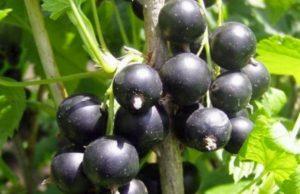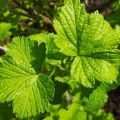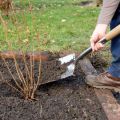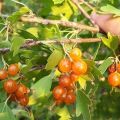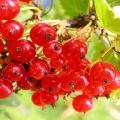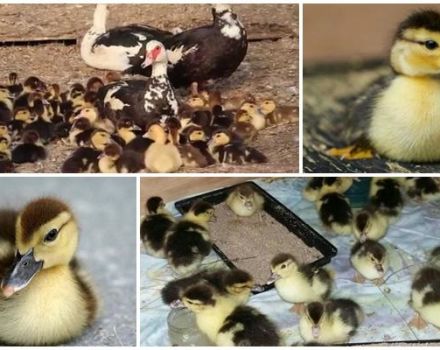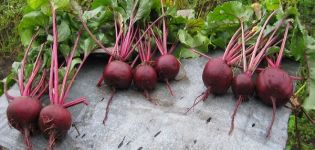Description of currant varieties Dar Smolyaninova, planting and care features
The varieties of black currant on the market are very diverse. It is she who is more in demand among gardeners than the rest (golden and red). She not only has excellent taste and aroma, she is just a storehouse of vitamins. There are 8 times more of them in currants than in citrus fruits. One of the most popular currants is the Dar Smolyaninova variety.
How the variety was bred
The variety was bred at the All-Russian Research Institute of Lupina, when crossing hybrids of the 4-15-90 and 42-70 cultivars. The creators were Astakhov A. I. and Zueva L. I. Included in the State Register of varieties permitted for use in the Central Region since 2007.
Biological description of the culture
A very early grade, approved for use in the Central and Volga-Vyatka region. Smolyaninova's gift is self-fertile, resistant to frost and drought. Medium resistant to fungal diseases (anthracnose and powdery mildew).
Bush and root system
The bush is medium in size, moderately spreading and dense. Shoots are erect, olive green, matte, of medium thickness. The leaf is large, wrinkled, three-lobed, with a convex and bare plate, light green in color. Black currant has a fibrous root system, no main root and moderate branching of small lateral roots. They are located in the surface sphere of the earth and reach depths of up to 40 centimeters.
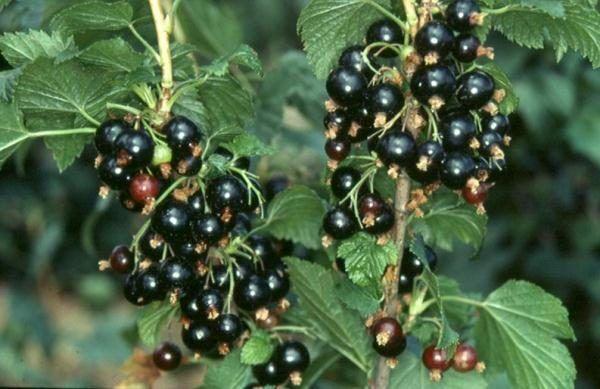
Flowering, berries and yield
The flowers are pale purple with reddish sepals. Raceme of medium length, sinuous and not pubescent. It has 6-8 flowers. Berries grow on a brush, not snug against each other. They are very large, weighing from 2.08 to 4.5 grams each. The black berry is round, with a dry separation.
The peduncle is thin, green, of medium length. The yield (average) is: 13.3 tons / hectare (you can get 2 kilograms of berries from one bush) and the maximum: 17.2 tons / hectare (2.6 kilograms from a bush).
Characteristics of black currant
The chemical composition is very rich: vitamins, macro- and microelements. Vitamins that make up black currant:
| Vitamin name | Amount, milligrams per 100 grams of berries |
| RR | 0,3 |
| Beta carotene | 0,1 |
| AND | 17 |
| B1 (thiamine) | 0,003 |
| B2 (riboflavin) | 0,004 |
| B5 (pantothenic acid) | 0,4 |
| B 6 (pyridoxine) | 0,1 |
| B 9 (folic acid) | 5 |
| FROM | 200 |
| H (biotin) | 2,4 |
| E | 0,07 |
Macronutrient table:
| Macronutrients | Amount, milligrams per 100 grams of berries |
| Potassium | 350 |
| Calcium | 36 |
| Phosphorus | 33 |
| Magnesium | 31 |
| Chlorine | 14 |
| Sulfur | 2 |
Micronutrient table:
| Trace elements | Amount, milligrams per 100 grams of berries |
| Iron | 13 |
| Iodine | 1 |
| Copper | 130 |
| Manganese | 0,18 |
| Fluorine | 17 |
| Boron | 55 |
| Molybdenum | 24 |
| Cobalt | 4 |
| Zinc | 0,13 |
Calorie content - 44 kilocalories. Contains proteins - 1 gram, fats - 0.4 and carbohydrates - 7.3 grams per 100 grams of currants.
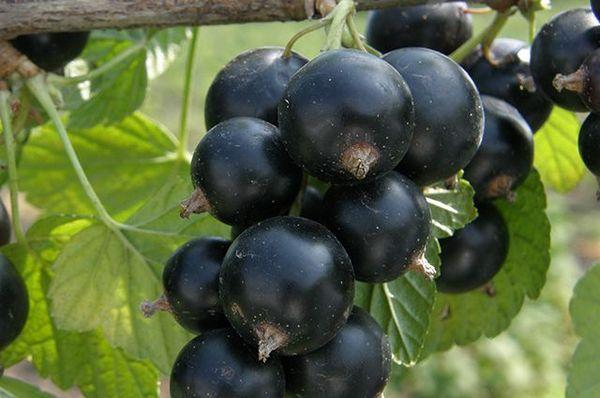
Resistance to freezing temperatures and drought
The variety Dar Smolyaninova belongs to the varieties of currants that are resistant to frost and drought. The shrub does not require shelter for the winter and tolerates spring frosts well. Recovers quickly and easily after the winter season. In dry weather, currants need to be watered often and the ground under the bush should be mulched so that the moisture remains for as long as possible.
Exposure to ailments and parasites
Smolyaninova's gift is resistant to fungal diseases (anthracnose, septoria and powdery mildew). Not susceptible to kidney mites.
Important! You cannot plant black currants near bird cherry, buckthorn, hyssop and fennel! Pest infestation may occur!
How to plant a variety on the site
To grow this variety on your site, you must follow some important planting rules for black currant, taking into account the characteristics and needs of this variety (soil, light).
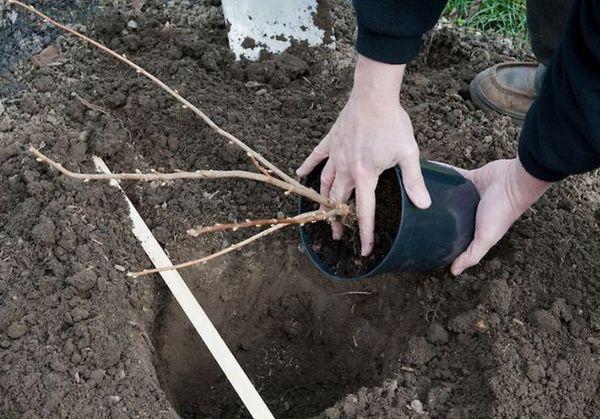
The best time frame for work
The best dates for planting are late September and early October. Before the onset of cold weather, the roots should settle well and harden in the ground. This time will be enough, and new shoots will start in the spring. Can be planted in spring, only early. Before the kidneys begin to awaken, and the sap flow begins.
Selecting a seedling and planting site
The landing site must be sunny and preferably protected from the north winds. Experienced gardeners recommend planting along fences or paths.
Currants can grow in any soil, except saline and swampy, with low air permeability, as well as in areas flooded with flood waters. In such areas, the bushes need to be planted on a hill or made mounds.
If the soil is too light, sandy or, conversely, heavy and clayey, it must be fertilized with compost or humus before planting a bush. The most desirable soil for this crop is slightly acidic.
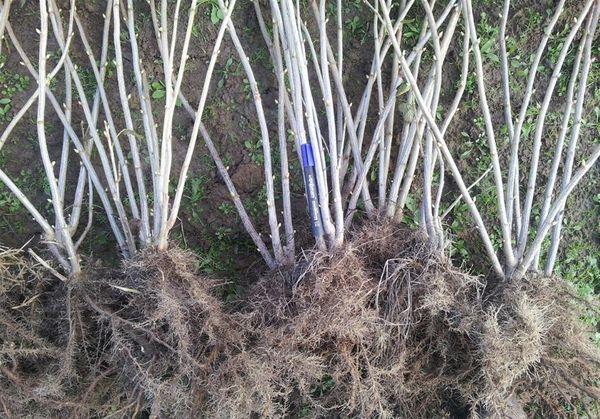
It is advisable to choose a two-year-old seedling that has already passed the first shaping pruning. It is done in order to increase the density of the bush. The root system should already be well formed. Leaves and shoots must be clean and healthy with no visible disease.
Cooking the beds
When planting currants in the fall, the beds are prepared in advance. In the spring - the ground needs to be prepared in the fall. To do this, it is necessary to add nutrients to the soil, per 1 square meter:
- humus - 10 kilograms;
- wood ash - 1 kilogram;
- superphosphate 100 - 200 grams.
Mix everything well and dig up, adding this nutrient mixture.
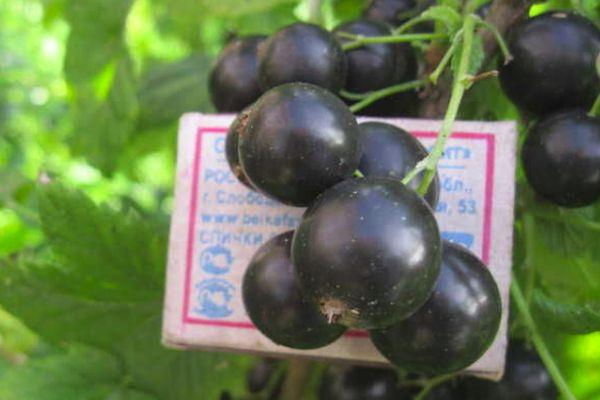
Currant planting technology
There is nothing difficult in planting this culture, the main thing is to follow some rules:
- Prepare the site in the fall or winter.
- Dig it up and fertilize it: add 10 kilograms of humus to 1 meter.
- Fill the disembarkation pits with nutrient mixture 2 weeks before the intended disembarkation. The pit should be about 50 centimeters deep and wide. Mix the soil from the pit with 2 tablespoons of superphosphate, a handful of wood ash, and 5 kilograms of compost. Stir and fill the hole 2/3 full.
- Wait until the soil has settled and compacted.
- Pour 5 liters of water into the hole.
- Place the seedling in the hole, maintaining an angle of 45 C.
- Spread the roots, sprinkle with earth on top and press down a little with your hand.
- Pour another bucket of water.
- Then you need to cut the shoots, leaving 2-3 buds on each.
After planting, the currants will need care.
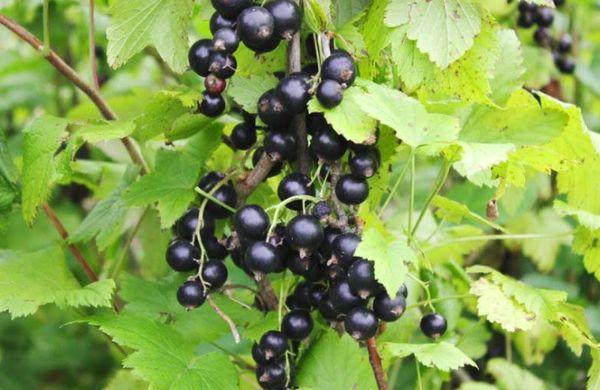
How to properly care for your culture
Care is simple, it includes: watering, pruning, fertilizing.
What and when to feed
Fertilizer is applied evenly to the soil. The diameter should be equal to the size of the crown of the shrub itself. It can be scattered over the surface before watering or shallow embedded in the ground (5 centimeters).
In the spring, the plant is fertilized 2 times:
- in the beginning of flowering phase;
- in the phase of berry formation.
If all the fertilizing was done before planting the bush, then the plant is not fertilized for 3 years.
The first spring feeding includes:
- organic fertilizer solution (chicken droppings, rotted manure);
- complete mineral fertilizer;
- a mixture of organic and mineral fertilizers.
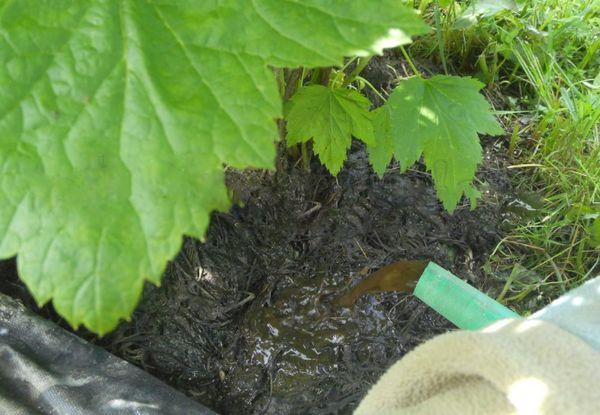
Top dressing from manure is prepared as follows: 1 part of mullein, 25 grams of urea or nitrate is added to 10 liters of water. If you use chicken manure instead of mullein, then you need to take 13-15 liters of water. Organic fertilizers can be replaced with nitroammophos, in the amount of 40 grams per bush.
The second spring feeding should bring trace elements to the plant. You can apply:
- Wood ash - 200 grams under a bush, with further shallow loosening and moistening.
- A mixture of humus and potassium sulfate.
- Mineral fertilizers with microelements, for example, Kemira, Yagodka.
These dressings are applied to the ground under a bush or sprayed (foliar dressing). For spraying 10 liters of liquid, 10 grams of fertilizer are taken.
A week after the first root, the first foliar feeding is performed. They use not only ready-made preparations, but also an infusion of wood ash, boric acid.
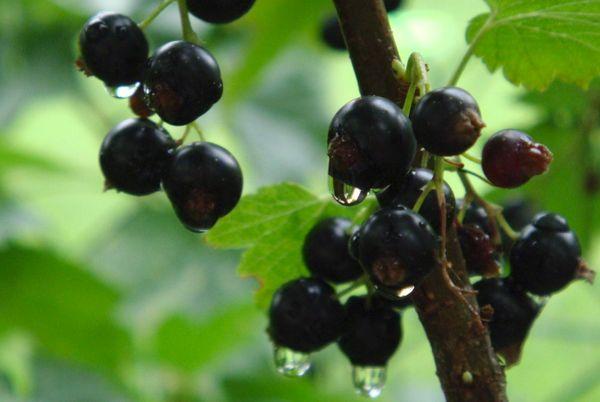
The second foliar dressing should be carried out during the ripening of the berries.
In autumn, phosphorus-potassium fertilizers are introduced into the soil. The first fertilization should be done immediately after picking the berries, the second - in a month, and the third - in November (add organic matter). The third dressing will take effect in 3 months (in spring).
How often to water the bush
This culture is very hygrophilous, so it needs regular watering - 2-3 times a week. If the currant receives less moisture, its yield drops, and the berries become smaller. For one watering, one shrub needs 3-4 buckets of liquid.
Shaping and rejuvenating pruning
Bush pruning should be done in early spring, before buds appear. First, branches damaged by diseases and ticks are removed. Also broken and withered.
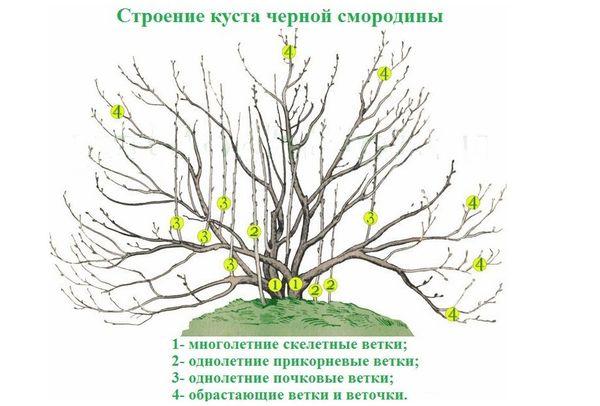
Anti-aging pruning. Unlike red currants, black currants are capable of producing multiple zero shoots. This is the reason for the large thickening of the shrub and its very rapid aging. They need to be removed in time, and only branches should be left to replace the old ones that have fruited.
Formative pruning. All shoots older than 3 years are removed. Because the first crop of a branch is 27% of 100% of the crop for the life of a currant. The second - 50%, and in other years - only 13%. Therefore, there is no need to be afraid to cut the branches, because they will no longer bring a good harvest.
This is the key to a well-formed bush, with 12 erect shoots, as well as annual and biennial branches, which should be equally divided. If pruned correctly, then the shrub wakes up to bring good harvests annually.
Loosening and mulching the soil
The soil around the bush must be dug up and mulched with sawdust or humus. The thickness of the mulch should be about 5-10 centimeters.

The next day after watering, the land near the bush must be loosened and sprinkled with hay or sawdust. Weeds that appear must be removed immediately so that they do not infect the plant with diseases or pests.
Preventive treatments
For prevention purposes, it is necessary:
- Get healthy and robust cuttings.
- Systematically inspect plant bushes for diseases.
- Destroy the vectors of infections (aphids, ticks) with chemical or biological agents.
- Observe the dosage of dressings, since an excess of nitrogen fertilizers provokes viral diseases.
At the end of winter, pour boiling water over currant bushes to destroy pests and their larvae.
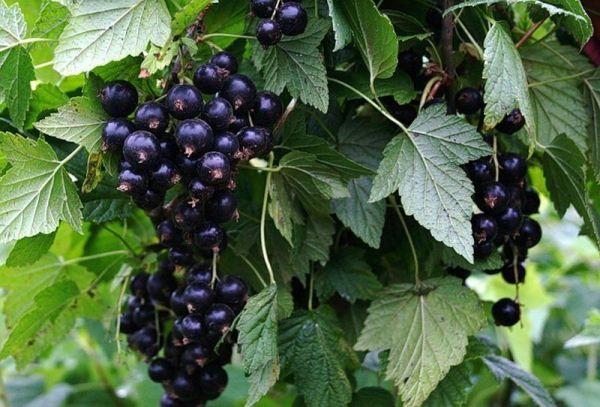
Shelter from frost
This variety tolerates winter well, but sometimes early frosts can catch the plant by surprise. For protection, it is necessary to cover the bushes with a covering, non-woven material or put on large paper bags.
Currant reproduction technique Dar Smolyaninova
Some experienced gardeners practice currant propagation. It is not very difficult, the main thing is to choose healthy cuttings for this purpose.
Breeding methods:
- cuttings;
- layering;
- dividing the bush.
Reviews of currants
Igor Petrovich, retired, 64 years old.
"I have only the best varieties of currants on my site, and Dar Smolyaninova is one of them."
Elena, 46 years old.
“I really love the Dar Smolyaninova currant for its aroma and large and sweet berries. Before, I used berries only for conservation, but I eat this variety fresh, and I am very happy. "
Zoya Petrovna, 54 years old.
“I live in the suburbs. I have been growing this variety for 7 years. He not only has delicious berries, he tolerates our winters very well. I am very pleased!"
The Dar Smolyaninova variety has established itself only on the positive side. It is versatile and ripens early. Berries are not only tasty, but also very healthy. Jam and broth, due to the high content of vitamin C, doctors recommend using it for flu and acute respiratory infections.
